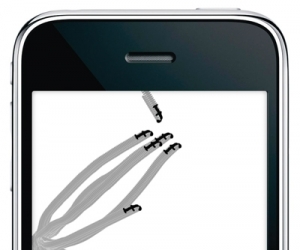
It’s a sensation particular to staying up all night—that in-between place on the cusp of complete exhaustion and utter lucidity, where fatigue and receptivity somehow reach a simultaneous peak. No longer fighting to stay awake, you’re charged with a directionless urgency, susceptible to the slightest resonance. Attention roams like a bright focused light searching for something to illuminate.
On September 30 2006, The Waves (Marcus Boon and Christie Pearson) organized an event called Nightswim for Toronto’s inaugural Nuit Blanche. The proceedings featured several electronic musicians, sound artists, and DJs of various persuasions, whose performances were transmitted through an array of underwater speakers at Trinity Bellwoods Pool. Just after 3 a.m. the sizable crowd had both thinned and become more boisterous. A cluster of bathers had further disrobed and begun flailing about drunkenly—splashing each other and wrestling flirtatiously. The water however, was surging with thick, plangent music. I had lost track of my friends and was floating aimlessly, eyes closed, ears enveloped. While the music was also blaring brightly over the house PA, filling the room, the underwater listening offered the chance to hear it without the din of inebriated punters. The sound was broad, heavy, and constantly active, yet betrayed its sense of suspension—weightlessness, stasis. Though smeared, opaque, and intangible, there was an ecstatic opalescence that danced on its surface, and a warm underlying tranquility. The setting, sharing some of these characteristics as it did, was perfectly appropriate for listening to Tim Hecker’s music.
The year Nightswim took place, Hecker had just released Harmony In Ultraviolet and had begun to fully embrace his uniquely complex and covertly contradictory sound world. Neither shunning nor courting sentimentalism, neither rejecting nor cultivating a sense of cinematic broadness, this release foregrounded formerly latent elements of his style to imbue the work with a momentum and depth that had been absent in his earlier work. His previous albums felt designed to represent a liminal state through their rippling quasi-stasis, but with Harmony In Ultraviolet Hecker had plunged headlong into liminality, producing dynamic and unpredictable sonic trajectories; and the process itself began to reflect that.
“I don’t even know what [sound] source and destination really mean anymore,” says Hecker, when asked about his work. “My working process is so weird that I’ll start a piece that may be written with a sample bank of instruments and then I’ll process that, and get some motif going, then write the score out, have someone play, record that, and then process that even further. I just keep hammering at the work until it takes shape.” While the image of a blacksmith at a forge is vividly apt in terms of his methodology, the notion of his work taking shape seems at odds with the fluidity and omnidirectionality of movement that are present in his recent music.
Hecker first came into prominence around 2000, emerging from the richly cross-pollinated Montreal scene that included labels like Constellation, No Type, and Alien8 (Hecker’s early home), and artists as diverse as Godspeed You Black Emperor!, Alexandre St-Onge, Akufen, Sam Shalabi, and Michel F. Côté. After generating a couple of techno records under the pseudonym Jetone, including Ultramin for noted label Force Inc., his focus quickly shifted toward his characteristic coarse blur, which was executed under his own name, and which assimilated several facets of Montreal’s varied musical landscape.
Hecker’s solo work “stemmed out of failures in musical groups,” he says. “Friends that didn’t commit, bands that never bore fruit. I came into electronic instruments, first through acquiring a sampler as a way to replace traditional instruments, then drifted farther and farther into forms of abstraction.”
Even Hecker’s debut under his own name, Haunt Me, Haunt Me, Do It Again (2001), was indeed abstract, arguably to a greater extent than his more recent work. Simple, clear, and often conveying a sense of shimmering suspension, its nine pieces unfurl thin ribbons of sound tidily woven together under a cracked glaze of microscopic activity. Often favouring flickers of notes rather than bona fide melodies, the music seldom blooms into the warm, vast chordal swells found on later efforts, instead reclining in hovering drift. Though the music was understated and obscure, critics were quick to note Hecker’s uniqueness. The often-cynical Web site Pitchfork was among those who doled out generous praise for the disc, lauding Hecker as “the best-kept secret in the North American electronic underground,” and placing Haunt Me . . . “on the top tier of current abstract electronic music,” citing as peers Stars of the Lid, Fennesz, and Microstoria, who were at that time better-established artists than Hecker.
The subsequent release, My Love Is Rotten To The Core (2002), remains a somewhat bizarre aberration in Hecker’s catalogue. And naturally, given its gaudy cock rock base, it’s measurably more extroverted than its predecessor. Van Halen was actually the foundation and—to an extent—the inspiration for the record: Hecker generated its soundscape by plundering their guitar riffs, swarms of disembodied chatter culled from interviews, and concert clips. Transcending tongue-in-cheek PoMo sample-thrashing, though, My Love. . . steers well clear of blatant humour and instead transposes the sound-granulation techniques of Haunt Me. . . onto his chosen raw materials. The opening track, “Introducing Carl Cocks,” uses granulation to mutilate Van Halen’s macho guitar shred, which turns from nimble virtuosity into a pixelated loop, and is eventually smudged into obscurity. The bolder, thicker tone heard there and elsewhere on the EP, unquestionably foreshadow the mass and volume heard in later works. Where Haunt Me’s noisier edges were like sea glass, tempered by the album’s gentle ebbs and flows, My Love Is Rotten To The Core presented a jaggedness akin to a freshly shattered bottle of Bud sitting somewhere backstage at an arena.
Radio Amor (2003), released initially on Mille Plateaux and later reissued on Alien8, returned to the more diaphanous palette of his debut release, and garnered further acclaim from publications such as The Wire and again from Pitchfork.
Then, 2004’s Mirages, rather like its cover image, which showed greenish lights illuminating fog amid stark blackness, retreated further into darker terrain, yet offered more contrast, contour, and shape, foreshadowing the scope of Hecker’s newer pieces.
It was Harmony In Ultraviolet (2006), though, that marked a clearer breakthrough both in terms of aesthetic and visibility, laying the groundwork for subsequent projects. “What I’ve been doing more recently,” says Hecker, “has been more true to my aspirations, I’ve just developed the technical ability to execute it a bit better.”
Certain things are definitely clear: a strong affinity for the electric-blankets-of-distortion sound that My Bloody Valentine pioneered. The sense of space found in some of Brian Eno’s work is also present. Yet, thanks to Hecker’s dream-like compositional logic, it’s a much more complex and dynamic proposition than that.
Tangible—and even somehow catchy—fragments of music begin to surface more frequently: melodies, a pulse, discernible instrumental sounds, something faintly iterative. Yet they always seem to be at the mercy of a destabilizing, chaotic gravity that forces them to unravel, sink to the bottom, or disintegrate slowly before they’re able to assert themselves. The landscape of the music is constantly changing, without ever truly progressing in any narrative sense. Instead, it’s a celebration of opposites gently collapsing into one other; images dissolving as rapidly as they’re evoked; landscapes flattening into pure geometry and exploding back again out into dim throbbing lights and plumes of smoke; a flow of disjointed impressions. “I kind of think about the sound palette as a three-dimensional space,” says Hecker. “I try to play with perception and depth and ‘liveness,’ and related to this is physicality and intensity. It’s really difficult to dictate terms to the listener.”
The music is as elusive for its creator as it is for listeners. Hecker, while quite articulate, is definitely at odds with quantifying his own musical identity. Perhaps it’s primarily because he doesn’t really want to demystify it or commit to his own process too much, for fear that the self-scrutiny would hamper the requisite degree of creative immersion. “My musical identity still doesn’t make sense, and I don’t want to feel like I’ve formed a musical identity, because once you start to conceptualize that, you’re already trapped, you’re already lost. It’s about dismantling the ego and being open to possibility, as opposed to feeling comfortable about the notion that you’ve constructed a sound palette that bears your signature. The moment I feel that, I start to feel claustrophobic. That’s not to say that [my music] doesn’t have a common thread—it definitely does; but I try to not focus on that because it doesn’t help the work at all. It actually takes away from it.”
This model, or rather, lack thereof, has come to be the malleable spine of Hecker’s craft. Certain sonic preoccupations are discernible, but he is always being led by his own ears to expand his concepts of sound generation and manipulation, and of compositional structure. As such, he seldom finds himself adhering to set frameworks. Instead, congruent with his interest in space and the physical presence of sound, he often finds himself exploring manipulation at the intersection of electronic and acoustic sounds. “I’d say a big change in the past ten years is the difference in my signal processing and how it’s gone from a kind of really in-the-box core digital way, to a more open hybrid—analog–digital, digital–analog type of interaction. I use a lot of amplifiers; I use a lot of room tone. I like to take to digital sounds—something sampled [hammers a note on a keyboard]: percussive piano—and I’ll send it out through my amps at the back of the room, throw some ribbon mikes into the farthest corner and capture that and start working with that to push farther. Maybe I’ll send it back out through amps and start doing Lucier-style feedback loop improvisations. I tend to push digital sound in this sculptural way, so there’s this sort of plasticity.”
His two major solo outings since Harmony In Ultraviolet—An Imaginary Country, and Ravedeath, 1972—have both been exceptional in their evocation of spatial perspective, likely owing to careful navigation of the border between electronic and acoustic treatment. Though often bleary-eared and dense, each disc never loses it sonic focus. Clear delineations are established between the various strata, and despite the constant and resonant nature of many of the sounds involved, there is still a strong enough sense of gesture that the ear doesn’t become fatigued. In many cases on the more recent Ravedeath (2011), there’s a sense that Hecker’s aforementioned “push farther” isn’t quite as hard at all times. The listener often bears witness to acoustic sounds (primarily organ and piano, plus the sounds of audibly buzzy guitar amps) ballooning into sounds beyond their capacity, then changing into something else altogether, or even doing the reverse. The sense of these sounds transpiring in a room is also present, although the humidity, temperature, and illumination of that room seems to fluctuate over the span of the album.
Though Hecker’s work had received considerable attention from the media since the outset, 2012 brought him a somewhat baffling success—a Juno award. The Juno awards, while traditionally not quite as cautious as their American counterpart, the Grammies, are nonetheless couched in similar “Music Industry Award” terms. And a mere glance at his fellow nominees in the Electronic Album of the Year category indicate strong allegiances to the pop world.
What exactly set him apart, then? Well, for starters, Ravedeath, 1972 is devoid of conventional song structure, strong metric rhythm, and vocals. And the other nominees—people such as Austra, and Junior Boys—though by all means inventive and intriguing, were by and large building very much on pop frameworks. But was that really a selling point to the jurors? Hecker is not inclined to chalk it up to anything much beyond “the way the cookie crumbled in that situation. I still feel like the music is quite difficult, almost bordering on the academic. If it was the People’s Choice Award, I would’ve come last. It was a jury that railed against awards being the rewards for being popular. That’s normally what most industry awards are, but this was the inverse. So I would say that this was an activist, ‘black swan’ jury. How else could you describe it? How do you actually set the terrain of evaluation between four or five artists in that category who are all doing legitimately different work that’s in completely different fields? Comparing it is almost absurd. The fact that I came out on that one was a bit ridiculous. To me it just shows that the jury was favourable. I don’t think it really symbolizes anything beyond that.”
When pressed to speak on the broader implications of the award, in terms of people’s tastes, Hecker is reluctant to make any generalizations about whether audiences are more or less prepared to listen to abstract or experimental musics, even given the degree of saturation. “It’s easier to get weird music out there. Maybe it reaches a broader audience; I’m not sure. But I don’t know if I really buy that argument. I still think the popularity of something like this is relatively niche.”
Perhaps it is still the domain of a singular community, but within and outside his immediate community, Tim Hecker has found numerous aesthetic allies. Although there’s a long tradition in music criticism of typecasting electronic musicians, particularly those with a more abstract and introverted aesthetic, as lone mad-scientist types, it’s often not the case. And despite the fact that Hecker’s process is highly focused and idiosyncratic, he has a long history of fruitful collaborative partnerships of various sorts: as a guest, within the scope of his own work, and as an equal collaborative partner.
Given Hecker’s penchant for heavy and fuzz-marred textures, it’s not altogether surprising that some of his most sympathetic and compatible collaborators have actually come from the metal world. While that music’s uptight detractors often still insist upon painting metal in broad strokes of knuckle-headed conservatism, the fact remains that metal, like it or not, has long been a hotbed for loud-volume experimentalism. His remix for widescreen metal act Isis in 2003 notably shifted the group’s rock instrumentation into Hecker’s slurred digital domain. Related to that effort was the collaborative full-length Fantasma Parastasie, which paired him with Torontonian Aidan Baker, whose practice straddles the divide between the slow-textural-melody, ambient-metal, and his own varied and atmospheric solo work. On the disc, the pair extensively investigate aggressively frayed textures, but also manage moments of tender, wafting melodicism, making for a lovely, if unsurprising, fit.
The past year saw legendary Montreal electronic festival Mutek hosting a collaborative performance of Hecker and Stephen O’Malley of the thunderous (and drumless) avant-drone metallers Sunn O))) and doom-metal forebears Burning Witch. With Hecker using live computer-processed pipe organ, O’Malley unfurled walls of down-tuned resonance, filling St. James church. “It was an improvisational piece that we gave ourselves one or two days to prepare for. An audience comes expecting a fully executed, fully realized work, but this piece wasn’t exactly like that. Having said all that, I think it went really well. It was quite physical.”
Speaking about his choice of collaborators, Hecker remarks, “Perhaps it’s because I’ve worked most often under the general rubric of electronic music that I’m drawn to collaborations with an inverse to everything that clichés of electronic music counters—physicality, intensity, distortion, etc.”
Another recent meeting with the much-lauded electronic artist Daniel Lopatin (a.k.a. Oneohtrix Point Never) resulted in Instrumental Tourist, a recording on the other end of the spectrum. “We did a duo studio session for three days in April. We recorded in almost a jazz style of improvisation. We tracked, recorded it, and I mixed it myself over a few days in June. I say “jazz” in sort of a cheeky way—taking the tropes of jazz improvisation and the studio session, and taking electronics in the spirit of that kind of back-and-forth. You know—like shredding, as opposed to careful preparation. It’s an interesting hybrid, and it’s not how I would’ve imagined it turning out at all.”
Cheeky indeed. If the lead cut, a resolutely un-jazzy track called “Uptown Psychedelia,” is any indication, the record is leaner and more economical sounding than Hecker’s solo work, and even many of his collaborations. Queasily lush melodic passages drift through fibrous bursts of sound, luminous pulsations, and the distant staccati of ersatz instruments.
When asked about his newest, yet-untitled solo venture, Hecker is typically enigmatic, “Well, I’m trying to make sense of what it is right now. It’s at that point of asking what it is and not being sure, but I enjoy that not-knowingness.
“Largely, a lot of the work is more repetitive, and kind of neo-minimalist in some ways—really primitive synthesizers and organs, simple repetition, and kind of a rawness that had departed by the late ’70s in a lot of that work. I’m trying to work more in discernible melody clusters and rhythms, actually—imploded arpeggios and motifs that are clearly in the Dorian mode, that are clearly referencing and stepping off from that domain of work. I’m trying to keep it in the domain of rawness. I’m not exactly sure how that’s taking shape, but that’s my intention—to examine that or go in that direction.”
Hecker’s answer brings to mind my encounter with his work back in 2006 at Nuit Blanche. As I floated in the pool and the set drew to a slow close, leaving only a dim underwater roar and the hedonistic cacophony of giggles and skin slapping against the surface, I began to feel exhaustion set in, and with it, a slew of different conflicting emotions. Though it’s tough to pinpoint the sensations or describe what affected me, I was haunted for weeks afterwards by the sound of “Blood Rainbow,” one of Hecker’s tracks played that night. Sometimes it’s not about descriptors or intellectual extrapolations. Hecker may have it right: maybe it’s just about visceral and highly evocative experiences in sound.
Audio: The Piano Drop (2011). Composed by Tim Hecker. Performed by Tim Hecker with additional piano by Ben Frost. Image: Tim Hecker. Image by: Jean-François Bérubé.


